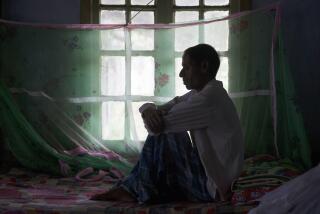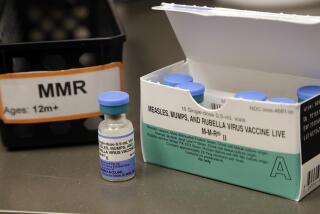TB Remains Persistent Problem in the U.S.
- Share via
Few people seem to know that tuberculosis, once the leading cause of death in the United States, continues to affect large numbers of Americans.
Tuberculosis rates hit an all-time high in the late 1800s, when the majority of the U.S. population was infected. But improved living conditions and better nutrition helped reduce the number of people who contracted TB, and the development of the first truly effective drugs against TB, in the 1940s, further reduced the spread of infection. Deaths attributed to this disease were almost completely eliminated in this country.
Even with these scientific advances, however, it has not been possible to eradicate tuberculosis. An estimated 10 million to 15 million Americans are currently infected with the bacteria that causes tuberculosis, and more than 17,000 cases of active disease were reported to the federal Centers for Disease Control and Prevention in 1999. Although tuberculosis rates in Los Angeles are high compared to most U.S. cities, the number of active TB cases declined by almost 50% between 1992 and 1999, to 1,170.
A healthy immune system is usually able to keep the tuberculosis bacteria in check, so only about 10% of people who are infected with TB bacteria actually develop the active form of the disease and become sick. This is more likely to occur in people with medical conditions such as HIV infection, malnutrition and diabetes, and in individuals using medications that weaken the immune system. Older adults and young children are also more susceptible to developing the active disease if they are infected.
When bacterial spread occurs, it is usually confined to the lungs. In about 15% of cases, the infection may also involve other organs such as the liver, kidneys, brain and bones. Persistent coughing is the most common symptom of active TB. Tuberculosis in the bones can result in spinal fractures, compression of the spinal cord and paralysis; TB in the brain can cause seizures. Individuals with active tuberculosis often experience weight loss, fevers and fatigue.
*
Tuberculosis is spread from person to person, but only by people with the active disease; a person who has been infected with TB bacteria but does not have the active disease is not contagious. The bacteria is transmitted through the air on tiny droplets that are expelled from the lungs when a person with active TB coughs, sneezes, talks, spits or laughs. Infection can occur when these droplets are inhaled by another individual.
Because most people with tuberculosis expel relatively few bacteria, it is much less contagious than other respiratory illnesses, such as influenza. Tuberculosis is not transmitted through contact with an infected person or even by sharing eating utensils or food with such an individual.
A simple skin test (the tuberculin or Mantoux test) can usually determine if a person has ever been infected with the tuberculosis bacteria. The test is done by inserting a small amount of protein extract from TB bacteria into the skin of the forearm, and examining the area 48 to 72 hours later to see if a reaction has occurred. Infected individuals will develop a raised red welt around the injection site. A positive skin test does not mean that the disease is active; it only suggests that you have been exposed to and are infected with the bacteria. To differentiate infection from active TB, a chest X-ray is needed. (Active TB produces characteristic abnormalities on a chest X-ray.)
It is important to identify infected individuals, whether they are sick or not, because preventive therapy greatly reduces the likelihood of becoming ill from active tuberculosis. A six- to 12-month course of isoniazid (the drug most commonly used for this purpose) reduces the chances of developing active tuberculosis by as much as 90%.
*
The Los Angeles County Department of Health Services recommends that people who belong to the following high-risk groups be screened for tuberculosis and treated preventively if their skin test is positive, even if active disease is not present:
* Men, women and children who are infected with HIV or at risk of HIV infection.
* Close contacts of people with active TB disease.
* Individuals who abuse drugs or alcohol.
* People with medical conditions that weaken the immune system, including diabetes, severe kidney disease, and cancers of the blood.
* Individuals using medications that weaken the immune system, including steroids.
Screening is also recommended for foreign-born individuals who have recently immigrated to the United States from areas where tuberculosis is very common (this includes Asia, Africa, Latin America, Eastern Europe and the Pacific Islands); medically underserved, low-income men, women and children; and residents and staff of long-term-care facilities, including nursing homes.
When active tuberculosis is discovered, it can almost always be successfully treated with a combination of medications. Soon after beginning medications, the person will no longer be contagious, although treatment for six months or more is required to prevent a recurrence.
*
Several counties in California, including Los Angeles County, require that all children be screened for tuberculosis before entering school for the first time in the state.
Tuberculosis skin testing can be performed by your regular medical provider or at one of the Los Angeles County Department of Health Services District Public Health Centers. The centers provide the test free of charge. To find a center near you, call (800) 427-8700.
*
Dr. Jonathan Fielding is director of public health and health officer for the L.A. County Department of Health Services. Dr. Valerie Ulene is a board-certified specialist in preventive medicine practicing in Los Angeles. They can be reached by e-mail at [email protected]. Our Health runs the second and fourth Mondays of the month.






